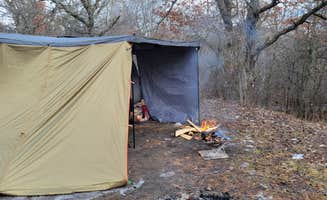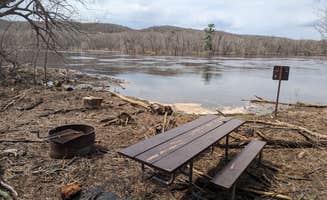Dispersed camping near Robbinsdale, Minnesota offers primitive outdoor experiences within an hour's drive of the Twin Cities metropolitan area. The region features sandy soil composition with mixed pine and hardwood forests. Campsites are primarily located along unpaved forest roads with variable accessibility depending on recent weather conditions and seasonal changes.
What to do
Hiking forest trails: Sand Dunes State Forest contains multiple hiking paths through varied terrain. "I was able to walk in and find an incredible spot to camp and lay in my hammock," notes one South of Sand Dunes State Forest visitor. Many trails connect camping areas to wider forest exploration.
Bird watching: The forest area hosts diverse bird species that change with seasons. "This is a nice quiet area... Quiet with lots of different bird sounds," reports a camper at South of Sand Dunes State Forest. Morning hours typically offer the best bird watching opportunities when species are most active.
River access recreation: Riverside camping provides water activity options. "The spot is along the ice age trail. Well managed gravel trail to the south and single wide footpath to the north," writes a visitor to Sandy Cove on the St. Croix River. The St. Croix offers seasonal kayaking and fishing opportunities when water levels permit.
What campers like
Solitude and quiet: Many campers appreciate the relative seclusion of these rustic sites. "Came back on a warm weekend. A bit more traffic, but after 12 p.m., not much of anything," reports a repeat visitor to South of Sand Dunes State Forest. Weekday camping typically offers the quietest experience.
Proximity to urban areas: The accessibility from Robbinsdale and surrounding suburbs makes these locations practical for quick getaways. "For the proximity to the city and nearby highways, this was a good spot," writes one camper about Sand Dunes State Forest camping areas. Most sites can be reached within 60-90 minutes from Robbinsdale.
Multiple camping options: The dispersed areas provide various site configurations. "There's lots of little spots off the main gravel road. Nothing allowed further into the forest. One pull through area that I found," notes a visitor to South of Sand Dunes State Forest. Sites vary in size, shade coverage, and privacy levels.
What you should know
Vehicle considerations: Forest road conditions can affect accessibility. "I stayed here for one night and roads were totally fine for any vehicle," reports one camper, but conditions vary seasonally. Some roads may become rutted or muddy after rain.
Wildlife awareness: Local wildlife includes various birds and mammals. "Stand storks are very protective. Stay away from them. They attack," warns a camper at South of Sand Dunes State Forest. Proper food storage and wildlife distance protocols are essential.
Variable cell service: Connectivity is inconsistent throughout primitive camping areas near Robbinsdale. Most locations have limited to no reliable service regardless of carrier, requiring advance planning for navigation and emergency contacts.
Road traffic concerns: Some forest roads experience unexpected traffic. "This road is pretty busy for a dirt forest road and people FLY down it. Almost got hit a few times walking," cautions a visitor to South of Sand Dunes State Forest. Use caution when walking near roadways, especially at night or with children.
Tips for camping with families
Choose established sites: Families benefit from sites with established fire rings and clear boundaries. "Plenty of spots. Fairly small spots," notes one camper about South of Sand Dunes areas. Arrive early on weekends to secure optimal family-friendly locations with adequate space.
Pack insect protection: Mosquitoes and ticks are common in Minnesota's wooded areas. Long sleeves, insect repellent, and regular tick checks are necessary, especially in warmer months when insects are most active.
Consider toilet access: Toilet facilities vary significantly between camping areas. Sandy Cove provides "a pad at the bottom of the path up to the open air vault toilet," according to a visitor to Sandy Cove on the St. Croix River. Other areas require completely self-contained waste management systems or strategic planning.
Tips from RVers
Height clearance issues: Overhanging branches affect taller vehicles in many camping areas. "Branches over hung, and rested on our camper (8ft high) and in fact most sites were shaded," reports an RV camper at South of Sand Dunes State Forest. Scout potential sites before committing to parking larger vehicles.
Limited trailer accessibility: Most dispersed sites accommodate smaller camping setups best. "Great spot. Plenty of parking. Best for straight vehicles or very small trailers," advises a visitor to South of Sand Dunes State Forest. Few pull-through options exist for larger rigs or trailers requiring turn-around space.
Local enforcement variations: Regulations interpretation may vary between enforcement agencies. "I called the DNR and they said that wasn't right but I decided to leave anyway. County sheriff's not pleasent around here," explains one RVer about potential conflicts regarding camping regulations.



